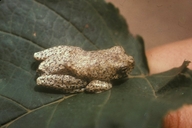|
Hyperolius nimbae Laurent, 1958
Nimba Reed Frog | family: Hyperoliidae genus: Hyperolius |
 © 2008 Arne Schiotz (1 of 2) |
|
|
|
Description This species shows developmental changes in patterning, with two phases, J (juveniles and many mature males) and F (mature females and some mature males). Phase J with hour-glass pattern. All newly metamorphosed individuals are phase J, which is normally brownish to green with paired light dorsolateral lines, or an hourglass pattern. All females, and some males, develop into phase F before the first breeding season. Phase F greyish with black spots and specks. Phase F is often colorful and variable, showing the diagnostic color characteristics for the species or subspecies. Either well-defined morphs may be present, or graded variation (Schiøtz 1999). Distribution and Habitat Country distribution from AmphibiaWeb's database: Cote d'Ivoire
Life History, Abundance, Activity, and Special Behaviors Comments A member of the H. viridiflavus complex. Once regarded as a subspecies of H. tuberculatus. Belongs to a group together with H. tuberculatus and H. hutsebauti, occurring in clearings in the forest belt. Probably closely related to the savanna-living Hyperolius viridiflavus complex. This account was taken from "Treefrogs of Africa" by Arne Schiøtz with kind permission from Edition Chimaira publishers, Frankfurt am Main.
References
Schiøtz, A. (1999). Treefrogs of Africa. Edition Chimaira, Frankfurt am Main. Originally submitted by: Arne Schiøtz (first posted 2001-01-29) Edited by: Kellie Whittaker, Michelle S. Koo (2022-10-09) Species Account Citation: AmphibiaWeb 2022 Hyperolius nimbae: Nimba Reed Frog <https://amphibiaweb.org/species/5707> University of California, Berkeley, CA, USA. Accessed May 23, 2025.
Feedback or comments about this page.
Citation: AmphibiaWeb. 2025. <https://amphibiaweb.org> University of California, Berkeley, CA, USA. Accessed 23 May 2025. AmphibiaWeb's policy on data use. |


 Map of Life
Map of Life